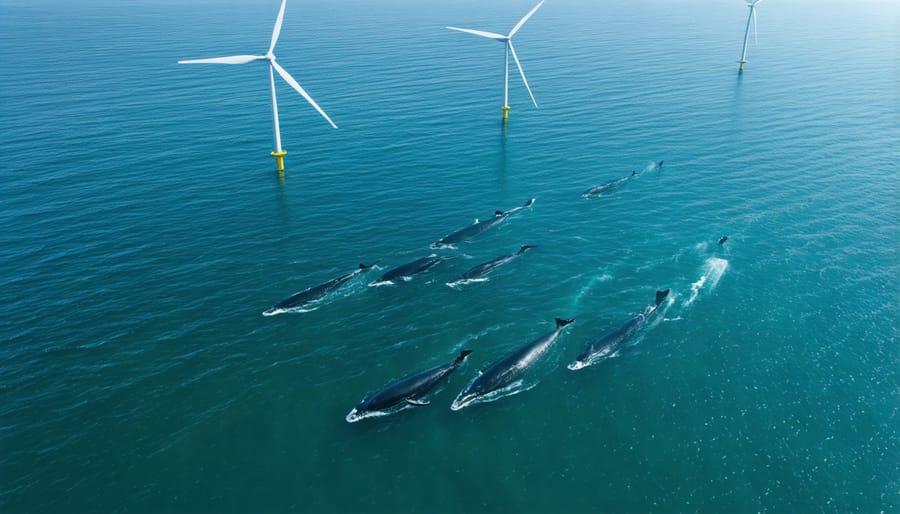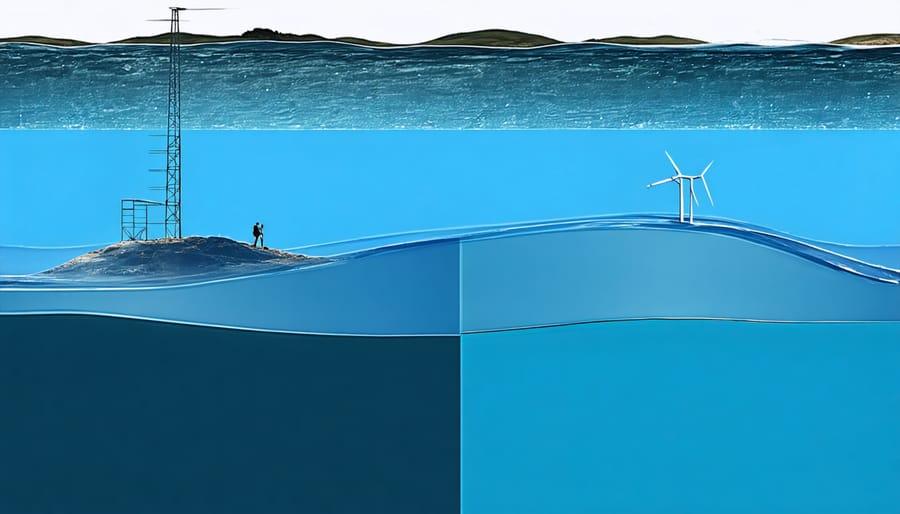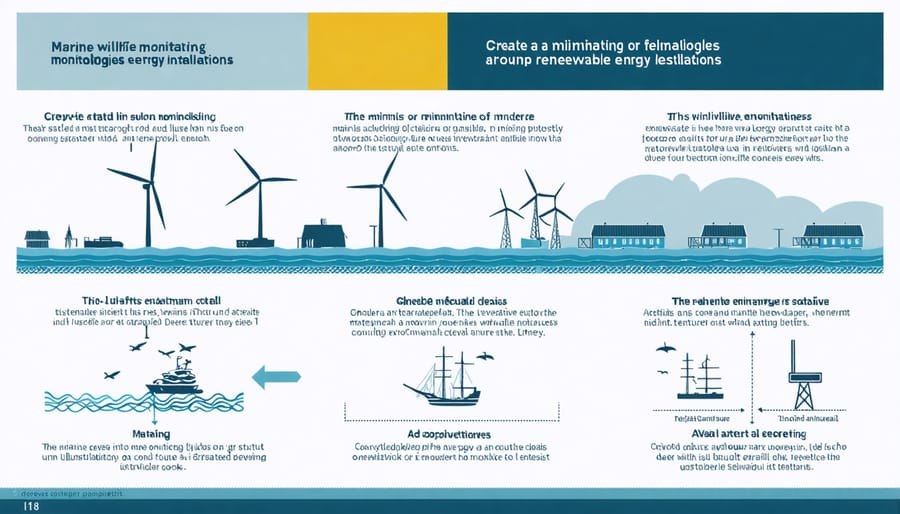
As renewable energy emerges as a critical solution for our planet’s future, we face compelling questions that demand thoughtful exploration and innovative answers. From the integration of massive offshore wind farms with delicate marine ecosystems to the development of wave energy technologies that can coexist with coastal habitats, the intersection of renewable energy and ocean conservation presents both unprecedented opportunities and complex challenges.
Marine scientists, conservationists, and energy developers are grappling with fundamental questions: How can we harness oceanic power while protecting marine biodiversity? What are the long-term impacts of renewable infrastructure on migration patterns and underwater ecosystems? How do we balance the urgent need for clean energy with the preservation of our ocean’s health?
These questions aren’t just academic exercises – they’re crucial considerations that will shape the future of our energy systems and marine environments. As we stand at this pivotal moment in human history, our answers will determine whether we can successfully transition to sustainable energy while safeguarding the precious ecosystems that sustain life on Earth.
Through rigorous research, innovative technology, and collaborative solutions, we’re working to answer these essential questions and forge a path toward a sustainable future where renewable energy and marine conservation thrive together.
Environmental Impact Questions
Wildlife Migration Patterns
The impact of renewable energy installations on marine wildlife migration patterns remains a critical area of study. Marine biologists and conservationists are particularly concerned about how offshore wind farms and tidal energy systems might affect the traditional movement paths of various species, from whales to sea turtles.
Recent studies utilizing advanced radar tracking systems have revealed that some marine mammals may alter their migration routes to avoid areas with intense underwater noise from construction and operation of renewable energy installations. However, the long-term effects of these behavioral changes are not yet fully understood.
Key questions researchers are investigating include:
– How do electromagnetic fields from underwater cables affect marine species navigation?
– What is the extent of displacement in traditional breeding grounds?
– Can we design wind farm layouts that minimize disruption to migration corridors?
Encouragingly, initial data suggests that some species adapt to these installations over time, with certain fish populations even using wind turbine foundations as artificial reefs. However, concerns persist about the cumulative impact on more sensitive species, particularly those already threatened by climate change and habitat loss.
Marine biologists are working to develop mitigation strategies, such as scheduling construction during off-peak migration seasons and implementing “quiet zones” during crucial migration periods. These efforts demonstrate how renewable energy development can potentially coexist with marine wildlife when properly planned and managed.

Habitat Disruption Concerns
The expansion of offshore renewable energy installations raises significant questions about their impact on marine habitats, particularly sensitive ecosystems like coral reefs. Marine biologists and environmental scientists are investigating how the construction and operation of offshore wind farms, tidal energy systems, and wave energy converters affect local marine life.
Key concerns include the disruption of migration patterns, changes in sediment distribution, and potential alterations to underwater soundscapes. These factors can significantly influence marine species’ behavior and their ability to communicate, navigate, and find food. For instance, the installation of offshore wind turbine foundations can temporarily disturb seabed communities, though studies have shown promising signs of marine ecosystem recovery once structures are established.
Coral reef systems present particular challenges, as they are highly sensitive to changes in water quality, temperature, and light penetration. Questions arise about how floating solar panels might affect reef photosynthesis processes and whether electromagnetic fields from underwater cables could impact coral larvae settlement patterns.
However, emerging research suggests that with proper planning and innovative design solutions, renewable energy installations can potentially create artificial reef environments that support marine biodiversity. Scientists are exploring ways to design infrastructure that serves both energy generation and habitat enhancement purposes, such as textured surfaces on turbine foundations that encourage coral settlement and growth.
The key lies in conducting thorough environmental impact assessments and maintaining ongoing monitoring programs to ensure that renewable energy development proceeds in harmony with marine conservation goals.
Technical Implementation Challenges

Installation Methods
When implementing renewable energy projects in marine environments, several critical questions must be addressed to minimize ecosystem disruption during construction. How can we reduce the impact on marine migration routes? Construction timing should align with periods of lower marine activity, particularly avoiding critical breeding and migration seasons for local species.
What methods can protect sensitive seafloor habitats? Installation teams should employ careful mapping techniques and utilize floating platforms that minimize contact with the seabed. Advanced sonar technology helps identify vulnerable coral reefs, seagrass beds, and other essential marine habitats that require special protection during construction.
How can we reduce noise pollution during installation? Sound-dampening technologies and bubble curtains can significantly decrease underwater noise levels that might disturb marine mammals and fish populations. Construction teams should also consider implementing “soft-start” procedures, gradually increasing activity levels to allow marine life to safely move away from the area.
What about sediment disruption? Installing specialized silt curtains and implementing careful dredging practices helps contain displaced sediment, protecting filter feeders and other sensitive marine organisms. Real-time monitoring systems can track sediment levels and adjust construction activities accordingly.
Can we create positive habitat opportunities during installation? Some projects incorporate artificial reef structures into their foundation designs, potentially creating new marine habitats while generating renewable energy. This approach demonstrates how thoughtful installation methods can actually enhance marine biodiversity.
Maintenance Considerations
The ongoing maintenance of offshore renewable energy installations raises important questions about their impact on marine ecosystems. Regular maintenance activities, including the use of marine robots and service vessels, can temporarily disturb marine life patterns. How frequently will maintenance crews need to access these installations, and what measures can be implemented to minimize disruption to marine species during these necessary operations?
Key considerations include the timing of maintenance activities to avoid critical breeding or migration periods, the use of environmentally friendly cleaning agents for equipment maintenance, and the development of wildlife-safe inspection protocols. Scientists are particularly concerned about the potential effects of underwater noise from maintenance vessels and equipment on marine mammals and fish populations.
Additionally, the accumulation of marine growth on structures requires regular cleaning, but this raises questions about the appropriate methods that won’t harm beneficial species that may colonize these structures. Some installations have become artificial reefs, supporting diverse marine communities, so maintenance practices must balance operational needs with ecosystem preservation.
Monitoring programs must assess both short-term disturbances and long-term effects of maintenance activities. This includes tracking changes in species behavior, population dynamics, and habitat use patterns around renewable energy installations. Through careful planning and adaptive management strategies, we can develop maintenance protocols that support both clean energy generation and marine biodiversity conservation.
Economic Viability Questions
Cost vs. Conservation Balance
One of the most pressing challenges in renewable energy development is striking the right balance between economic viability and environmental protection. While renewable energy projects offer long-term cost benefits and reduced carbon emissions, their initial implementation often requires significant financial investment. Environmental scientists and project developers must carefully weigh these costs against the potential impacts on marine ecosystems.
For instance, offshore wind farms present a compelling case study of this balance. While they generate clean energy and can create artificial reef environments that benefit some marine species, their construction and maintenance costs are substantial. Additionally, developers must invest in environmental impact assessments, monitoring programs, and mitigation measures to protect marine life.
Conservation measures, such as seasonal restrictions during migration periods or the use of noise reduction technology during construction, can increase project costs significantly. However, these investments often prove valuable in the long term by preserving biodiversity and maintaining ecosystem services that benefit both marine life and coastal communities.
Innovative financing models, including public-private partnerships and green bonds, are emerging to help bridge the gap between conservation needs and economic constraints. These solutions demonstrate that with careful planning and creative approaches, it’s possible to achieve both environmental protection and financial sustainability in renewable energy projects.
The key lies in viewing conservation measures not as obstacles to development but as essential investments in the long-term success of renewable energy initiatives.
Long-term Sustainability
The long-term sustainability of renewable energy projects raises crucial questions about their economic viability and environmental impact over extended periods. One primary concern is whether current renewable technologies can maintain their efficiency and productivity throughout their operational lifespan without causing unintended ecological consequences.
Marine-based renewable energy installations must demonstrate both economic sustainability through consistent energy generation and ecological sustainability by minimizing their impact on marine ecosystems. Questions arise about the durability of materials in harsh marine environments and their potential degradation effects on local wildlife habitats.
Researchers and conservationists are particularly interested in understanding how these installations will adapt to changing ocean conditions due to climate change. Will current designs remain effective as sea levels rise and weather patterns shift? Additionally, there are questions about the long-term maintenance requirements and whether they can be met without disrupting marine life.
The recyclability and end-of-life management of renewable energy infrastructure present another critical sustainability challenge. How can we ensure that decommissioned equipment doesn’t contribute to marine pollution? What strategies can be implemented to create truly circular systems where components can be recycled or repurposed?
These questions highlight the need for comprehensive long-term studies and adaptive management approaches that consider both the economic benefits and ecological preservation in marine renewable energy projects. Success will require ongoing collaboration between engineers, marine biologists, and environmental scientists to develop solutions that stand the test of time while protecting our oceans.
Future Research Needs
Monitoring Technologies
How can we enhance our ability to assess and monitor wildlife impacts from renewable energy installations? This question drives innovation in marine monitoring technologies. AI-powered monitoring systems are revolutionizing our capacity to track marine species interactions with offshore wind farms and tidal installations.
Key questions researchers are exploring include: Can we develop more accurate methods for detecting wildlife collisions? How can we improve real-time monitoring of marine mammal behavior around installations? What role can autonomous underwater vehicles play in continuous environmental assessment?
Advanced sonar technology and environmental DNA sampling are showing promise in providing more comprehensive data about species presence and behavior patterns. However, questions remain about the most effective combination of monitoring tools and the frequency of deployment needed for reliable impact assessment.
Emerging technologies like smart buoys equipped with multiple sensors and machine learning capabilities are helping answer these questions. These systems can process vast amounts of data to identify patterns and potential risks to marine life, enabling more responsive management strategies.
The challenge now lies in standardizing monitoring protocols across different marine environments while ensuring cost-effectiveness and reliability of these new technologies.

Adaptive Management Strategies
Successful marine renewable energy projects require flexible management approaches that can adapt to changing environmental conditions and emerging scientific insights. Key questions revolve around how to develop monitoring systems that can quickly detect and respond to environmental impacts. Conservation managers must consider how to establish clear thresholds for action and create decision-making frameworks that allow for rapid adjustments in operations when needed.
Another critical consideration is the development of collaborative adaptive management protocols that involve multiple stakeholders. How can we ensure effective communication channels between energy operators, scientists, regulators, and local communities? These protocols should include regular review periods and mechanisms for incorporating new research findings into management practices.
Practitioners are also exploring questions about technological adaptability. How can renewable energy installations be designed with built-in flexibility to modify operations based on environmental monitoring data? This includes considerations for adjusting turbine speeds, timing operations around marine species migrations, and implementing temporary shutdowns during critical ecological events.
Long-term monitoring strategies raise questions about data management and analysis. How can we develop systems that effectively track both immediate and cumulative impacts while maintaining the ability to modify monitoring approaches as new technologies and methodologies emerge?
As we navigate the transition to renewable energy in marine environments, several critical questions remain at the forefront of our collective efforts. The path forward requires careful consideration of both environmental protection and sustainable energy development, with scientists, policymakers, and communities working together to find balanced solutions.
Key questions about marine habitat protection, technology optimization, and economic feasibility must guide future research and implementation strategies. Success stories from pilot projects around the world demonstrate that with proper planning and monitoring, marine renewable energy can coexist with thriving ocean ecosystems. However, continued research is essential to better understand long-term impacts and develop more efficient technologies.
Looking ahead, the marine renewable energy sector must prioritize adaptive management approaches that respond to new scientific findings and emerging challenges. This includes developing standardized monitoring protocols, improving stakeholder engagement, and investing in innovative technologies that minimize environmental impacts while maximizing energy production.
The future of marine renewable energy depends on our ability to answer these complex questions through collaborative research, transparent communication, and commitment to environmental stewardship. By maintaining focus on both conservation and clean energy goals, we can work toward a sustainable future where marine renewable energy plays a vital role in addressing climate change while protecting our precious ocean ecosystems.
As we move forward, continued engagement from scientists, local communities, and industry partners will be crucial in shaping responsible development practices that benefit both our energy needs and marine conservation efforts.
jessica
Ava Singh is an environmental writer and marine sustainability advocate with a deep commitment to protecting the world's oceans and coastal communities. With a background in environmental policy and a passion for storytelling, Ava brings complex topics to life through clear, engaging content that educates and empowers readers. At the Marine Biodiversity & Sustainability Learning Center, Ava focuses on sharing impactful stories about community engagement, policy innovations, and conservation strategies. Her writing bridges the gap between science and the public, encouraging people to take part in preserving marine biodiversity. When she’s not writing, Ava collaborates with local initiatives to promote eco-conscious living and sustainable development, ensuring her work makes a difference both on the page and in the real world.
